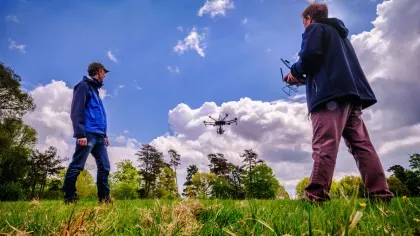15 July 2022
Nature Unlocked: Lessons from fungi
Discover how scientists at Wakehurst are helping to unearth the crucial role of fungi in our ecosystems.

Our pioneering research project at Wakehurst, Nature Unlocked, is exploring the value of UK biodiversity.
Through investigations into the vital role plants and fungi play in carbon storage at our 535 acre site, our scientists hope to influence landscape management on a national scale.
Meet the team
Our Mycology team, led by Dr Laura M. Suz, are unearthing secrets in the soil.
Laura's research focuses on mycorrhizal fungi which grow in harmony with plant roots, as an extension of the root system. They explore the soil more efficiently than roots alone and take sugars and fats from plants in exchange for vital water and nutrients.
Mycorrhizal fungi are key players when it comes to tree and forest health, as well as ecosystem processes like nutrient cycling and carbon capture.
The team, also consisting of Professor Martin Bidartondo, Dr Jill Kowal, Dr Jim Clarkson, and research assistant Benjamin Underwood, will develop a method to measure fungal diversity and carbon below ground at Wakehurst with the aim to scale it up to habitats UK-wide.
The data collected on carbon below ground will be combined with results from our high-tech drones (led by Senior Research Leader Dr Justin Moat) measuring carbon storage above ground.
In UK forests, approximately 80% of carbon is held in the soils, with the remaining 20% in above ground vegetation.
The team will also use readings from gas in the soil and the air above it, to measure how changes in soil across habitats affect levels of carbon in the air.

Why are we doing this research?
With a greater understanding of the relationship between above and below-ground habitats, we can help tackle global ambitions to become net zero carbon and develop nature-based solutions to critical issues such as climate change.
Justin stressed, 'Planting trees in the wrong place could have disastrous consequences in the next 50 to 100 years. With this research, we’ll discover new ideas as to how carbon can be stored and how we can all benefit from the landscape.'
We'll be able to encourage governments, landowners and even the public to make investments in the landscape, leading to the best outcomes for both humans and nature.
Laura commented, 'We want to come up with a scalable method that we can use to measure both below and above ground carbon across the UK. From there, we’ll be able to inform the public of the key function of fungi in carbon sequestration.'
Mycorrhizal mysteries
Research from Kew’s team already shows that changes in mycorrhizal fungi communities impact the growth of trees and mineral nutrition in forests, but this has not yet been linked to other processes like carbon sequestration.
This is what our mycologists have set out to uncover.
Using Wakehurst as their living laboratory, the team have taken hundreds of soil samples to examine the mycorrhizal fungi communities and their impact on the plants above them.
Laura explained 'Mycorrhizal fungi are the main organisms driving carbon storage — we can test how different proportions and types of these fungi affect sequestration both in the soil and above ground.”*
Using soil corers, the team are inspecting the roots and the composition of different fungi within.

The team are using a range of different techniques to take a closer look at the samples. This includes DNA sequencing to identify which fungi are in the roots and soil, and measuring levels of ergosterol (a component of the fungal cells) to detect the amount of fungi in the soil.
Laura added 'We’re also sending samples for soil analysis, to measure not only carbon but also other nutrients, pH, and soil factors that can affect fungi and their contribution to the ecosystem.'

Collaboration is key
The mycology team are working with horticulturalists at Wakehurst, other researchers and the local community to build a fuller picture of the landscape.
Justin shared, 'Historic insight from local communities can really help with the timeline. For example, we’ve been speaking to a family who have been coppicing one of our woodland research sites for over 20 years, providing greater insight to our results.'
Laura added, 'It’s so exciting to hear other researchers’ questions. We can be quite focused on the below ground elements, but now we’re working with people investigating the ground upwards!'
Combined with information from across the Nature Unlocked programme, this research will help us recognise habitats for their ecological value and appreciate the beauty of nature, not just for its above-ground features, but for the powerful changes going on in the soil.

Read & watch
References
- Suz LM, Bode J, Byrne A, van der Linde S, Bidartondo M. 2022. Nutrients, carbon, mycorrhizas and tipping points in forests. Quarterly Journal of Forests 116, 1: 36-43.
- Anthony, M.A., Crowther, T.W., van der Linde S, Suz, LM, Bidartondo MI et al. 2022. Forest tree growth is linked to mycorrhizal fungal composition and function across Europe. ISME J. https://doi.org/10.1038/s41396-021-01159-7
- Suz, LM, Bidartondo, MI, van der Linde, S, Kuyper, TW. 2021. Ectomycorrhizas and tipping points in forest ecosystems. New Phytologist 231:1700-1707.



